Having evolved from its origins as a social-online-platform for the cyclist, Zwift racing has grasped the attention of thousands of cyclists across the world. The competitive side in us human beings has resulted in an ever-growing ferocious world of pain, suffering, and stronger legs. From Brazil to New Zealand, riders from the deepest pockets of the world are consistently participating in this virtual racing.
I heard you want to become a master of Zwift racing (who doesn’t?).
You may currently be fearing Zwift racing – But when you see first-hand the gains in power and fitness, your perception may start to change. Zwift racing will without a shadow-of-a-doubt, leave you fitter and stronger, which is great. But we all want to win, right? Remember the competitive side in us?
Here are some points to maximize your chances of winning a Zwift race:
SET-UP: SET YOURSELF UP FOR A WINNING PERFORMANCE
Your set-up is a crucial factor to winning a Zwift race. Without adequate ventilation, hydration and comfort, your chances of winning are reduced and you will not achieve your maximum potential. Imagine yourself whilst racing on Zwift – What would you possibly wish for? An energy gel? A towel? That fan opposite you to be turned up a little more? Here is a kind of checklist that I run through my mind when preparing for a Zwift race:
- Towel
- Full water bottles
- Windows opened and a fan turned on to preferred setting
- Is my laptop in-charge?
- Bluetooth speaker and phone
Your checklist may differ to mine. Whether you need to write it down or are able to run through it in your mind, completing a checklist of equipment that will improve your performance, is worth doing so.
It’s up to you where you wish to set-up your stuff – I use to ride and race in my bedroom!
CHOOSING THE RIGHT VIRTUAL BIKE
Although it may seem like any old bike will do to start with, once you have completed a few Zwift races, you will be looking for easy ways to improve your performance. Choosing the right bike, although it may not seem an important factor, actually is.
The five fastest bikes currently in Zwift (credit to zwiftblog.com) are as follows (lap times are given for 1 complete lap of the Watopia Figure 8 course at a consistent wattage, weight and wheelset):
1. Concept Z1 (TRON bike) – Lap time: 50:52
 The TRON bike has the fastest lap times to offer as well as its incredible looks. It does require a bit of work to get it though – you’ll need to climb 50,000m, which is over 5 x height of Everest in Zwift, to unlock this bad boy!
The TRON bike has the fastest lap times to offer as well as its incredible looks. It does require a bit of work to get it though – you’ll need to climb 50,000m, which is over 5 x height of Everest in Zwift, to unlock this bad boy!
2. Cervelo S5 – Lap time: 50:58 (+6 seconds)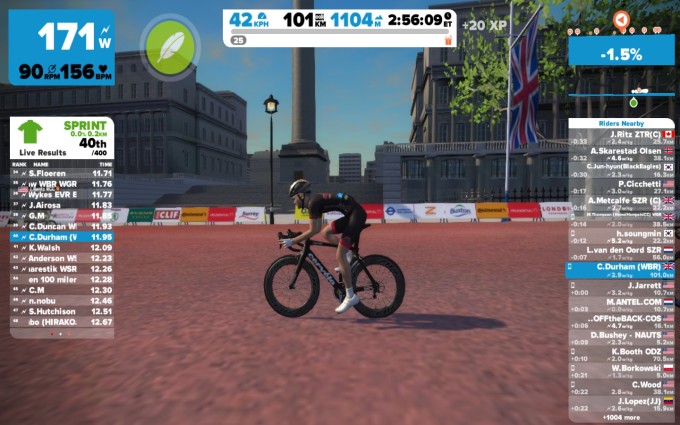 Probably my third favourite bike in Zwift, the S5 will require you to get to Level 24 before you can unlock it.
Probably my third favourite bike in Zwift, the S5 will require you to get to Level 24 before you can unlock it.
3. Trek Madone – Lap time: 51:05 (+13 seconds)
Below: Team dZi (now Team WBR) showcasing the Trek Madone. 
The Trek Madone looks the part, especially in red. You will need to get to Level 20 before you can unlock this beautiful piece of carbon fibre and speed.
4. Canyon Aeroad – Lap time: 51:06 (+14 seconds) My second favourite bike in Zwift, the Aeroad is purely a piece of art. Even though it is some 14 seconds slower than the TRON bike over the Watopia Figure 8 course, I will sometimes race with this bike because it looks so nice (especially in red). You’ll need to hit Level 22 before you can unlock this.
My second favourite bike in Zwift, the Aeroad is purely a piece of art. Even though it is some 14 seconds slower than the TRON bike over the Watopia Figure 8 course, I will sometimes race with this bike because it looks so nice (especially in red). You’ll need to hit Level 22 before you can unlock this.
5. Zwift Aero – Lap time: 51:08 (+16 seconds)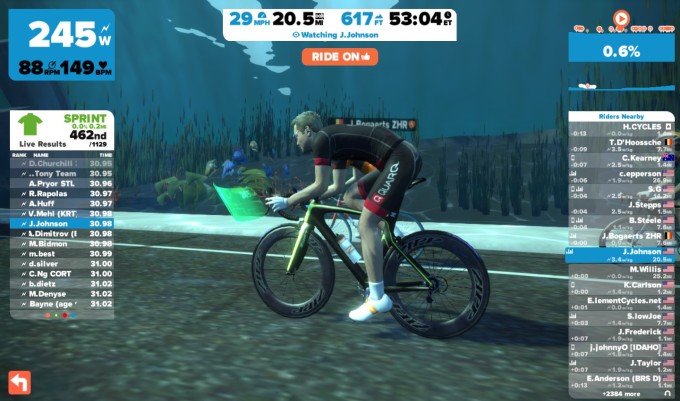 A great in-game bike, the Zwift Aero can be unlocked at just Level 13.
A great in-game bike, the Zwift Aero can be unlocked at just Level 13.
As you may have noticed, the Zwift TT bike has not featured in the Top 5 fastest bikes on Zwift. This is primarily due to the fact that most races do not allow TT bikes (I think it’s because they do not offer draft like a bike in the real world would do).
CHOOSING THE RIGHT RACE
Racing Categories – Don’t make it harder than necessary!
Choosing the right race category for you is very important. You stand very little chance of winning if you have an FTP of 2.5w/kg and are racing in the (A) category! The majority of races in Zwift involve categorization, based on your FTP.
Your FTP is your Functional Threshold Power. It is the power you can hold for one hour. To find out what your FTP is, you will need to do a specific test. You can either ride as hard as you can for an hour or ride as hard as you can for 20 minutes and multiply your 20-minute wattage by 0.95 (to factor in the fatigue you would encounter when riding flat-out for an hour). The majority of riders tend to use this second option, as the pain only lasts for 20 minutes 🙂
Here’s how riders are typically categorised:
- (A) Category – FTP of 4.0+w/kg
- (B) Category – FTP of 3.2-3.9w/kg
- (C) Category – FTP of 2.5-3.1w/kg
- (D) Category – FTP of 1-2.4w/kg
The length of a race on Zwift can vary, depending on which category you will be racing in. Typically, the (A) and (B) Categories will race further than the (C) and (D) Categories, to reduce the effect of their respectively higher average speeds. This usually results in a close finish between all categories. Most winners in each category will finish their race with an average w/kg value at the top-end of their category. For example, a Category (B) rider may win a race with an average w/kg of 3.85.
There is significant variation within a category itself, so don’t feel disheartened if you’re not finishing on the podium in your category. Moving up categories can be quite a painful leap, as you will most likely go from winning races to losing a lot of races. But hey, you’re progressing and becoming stronger.
HANDICAP RACES
Handicap racing in Zwift has grown throughout the last 6 months. In some cases, weaker riders may be given a time advantage over stronger riders, resulting in a close finish. In other cases, stronger riders may be handicapped by increasing their weight drastically, reducing their w/kg, and weaker riders may be allowed to decrease their weight, increasing their w/kg, so the whole field will ride around at a similar w/kg.
LENGTH AND TERRAIN OF RACE
The length and terrain of races have importance too. Your tactics will likely differ depending on the length and terrain of a race. You may save your efforts for the climbs, if it’s a hilly course, as it is very likely that everyone will nail it up these climbs, or you may save your legs for a breakaway in the final stages of a flat-course race. Take into account the climbs and descents of the race course. Pushing on descents and taking it relatively easy up climbs will diminish your chances of a win. Ride smartly.
For those who race outside in the real world, you will probably use Zwift racing as a training tool. Remember this when choosing a race. Choosing to race 100km if you will only race up to 40-50km outside IRL is not the most sensible choice. Consider choosing races of length that will reflect racing you’ll be doing outside.
Finding The Right Race For You
Have a look at the Zwift Events Calendar , Zwiftpower, and Teamup to find races right for you.
There can be anything from 10-17 races per day on Zwift! Races begin at different times throughout the entire day, catering for riders all over the world. In addition to the number of races, each race has it’s own unique length. Whether it be 100km or just 10km, you’ll be certain to find a length of race that you would like. The London course often features races on the ‘Classique’ route (each lap is 3.3 miles or 5.31km), and the ‘London Loop’ (9.2 miles or 14.9km), which features Box Hill.
Below: Box Hill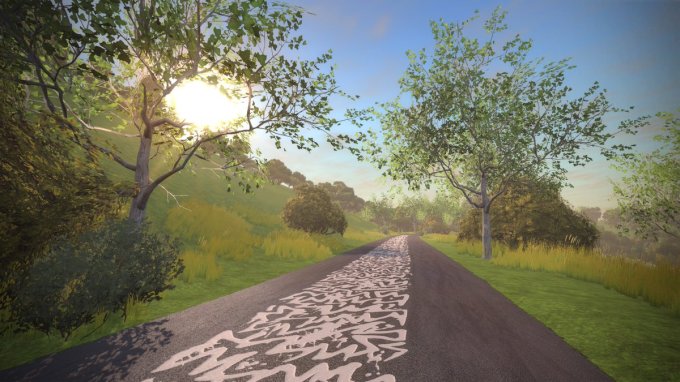 For those of you who haven’t yet ridden the London course, Box Hill is a long, nasty climb.
For those of you who haven’t yet ridden the London course, Box Hill is a long, nasty climb.
There are multiple race courses in Watopia. From the Mountain 8 route (20 miles or 32km, 2,221ft or 677m elevation gain) to the flat course, you are really spoilt for choice.
Individual Time Trials (ITT or TT) and Team Time Trials (TTT) are also carried out on Zwift.
Warm-Up
Your warm-up is essential to your race. I’ve not warmed-up properly on multiple occasions and have paid the price for it. An adequate warm-up will drastically increase your race performance. Here are a few suggestions for you to take onboard regarding your warm-up:
Have a power-up prior to entering the pen – During your warm-up, you will be able to receive a power-up when passing through the sprint, KOM or Lap banner out on course. You can carry this power-up from your warm-up to the race. This additional item will provide you with a small but beneficial improvement to stay with the mad racers who push 8+w/kg for the first 30 seconds of a race. A factor to bear in mind before you enter the race pen – Check your race organiser allows power-ups – Some race organisers prohibit the use of power-ups (usage may result in time penalty or disqualification).
You can find some of my warm-ups for races in my post ‘Suffer Buffet‘
3, 2, 1, GO!
Nail it out of the pen. The first 30 seconds – 1 minute will basically be a sprint. Then settle down into a good rhythm, and get into the draft of other racers. Watch your heart and breathing rate, and find the right cadence for you. Here’s an analysis of the first 30 seconds or so from a few races I have raced:
EVR (A) Race – First 2 minutes of the race:

I averaged 351w (5.70w/kg) for the first 75 seconds of this 2-minute extract. You can clearly see the large spikes in power (purple trace) in the first half of this image.
ZTR (A) Race – First 1 minute 30 seconds of the race:

My power output in this race gradually falls over the first 90 seconds. Notice the big burst of power at the very beginning?
Drafting – Ride Smartly
From the moment the race begins, saving every joule of energy is crucial. It may well help you to get over that climb with the leaders, or pip that competitor in the sprint to the line. To draft a racer well in Zwift, you need to be within 3 metres of that racer. You will still receive some draft from a competitor if you are within 5 metres, but the closer you are, the stronger the draft.
If you’re a light rider, maybe consider getting towards the front of the peloton before a descent. Heavy riders will bomb down descents faster than you, so take this into account. And vice-versa, of course. If you are a heavy individual (muscle, of course), consider hitting the climbs at the front of the peloton. You may be able to put out less w/kg than your rivals, yet stay with them as you crest the climb, as you hit the climb a few metres before they did.
Save your legs until they are really needed. Here’s a w/kg table from some race results (I actually won this race, as W.Kitchen was using ‘Zwift’ Power, which is often excluded from the results by numerous race organisers): Notice those who finished with a lower average w/kg above others, who finished with a higher w/kg figure? That’s because they drafted more effectively. Drafting well is important!
Notice those who finished with a lower average w/kg above others, who finished with a higher w/kg figure? That’s because they drafted more effectively. Drafting well is important!
Power-Up!
As I’ve said above, check your race organiser allows power-ups – Some race organisers prohibit the use of power-ups (usage may result in time penalty or disqualification). Features in Zwift are constantly evolving, and race organisers now have the ability to prevent power-ups from being acquired and used in their races.
The image below explains the effects of each power-up in Zwift:
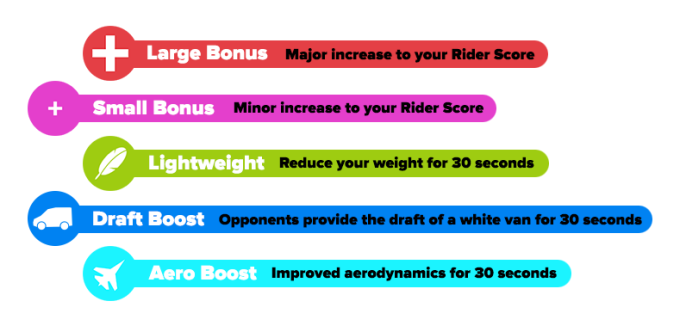 From aero-boosts to feathers, using power-ups will improve your racing performance for a short period of time. But in order to maximise the full effect of a power-up, you will need to use one at an appropriate time, and/or at an appropriate place. You will only receive 2-3 power-ups per lap, so you will need to use them sensibly. For example, using an aero power-up whilst climbing at speeds below 15mph (24.1km/h) is not as effective as using an aero when descending at speeds above 40mph (64.4km/h). Using a feather whilst descending is not as effective as using it when climbing. Choosing the moment to use a power-up is important. You’ll treasure them even more when you don’t have one.
From aero-boosts to feathers, using power-ups will improve your racing performance for a short period of time. But in order to maximise the full effect of a power-up, you will need to use one at an appropriate time, and/or at an appropriate place. You will only receive 2-3 power-ups per lap, so you will need to use them sensibly. For example, using an aero power-up whilst climbing at speeds below 15mph (24.1km/h) is not as effective as using an aero when descending at speeds above 40mph (64.4km/h). Using a feather whilst descending is not as effective as using it when climbing. Choosing the moment to use a power-up is important. You’ll treasure them even more when you don’t have one.
Sprint Like a Boss
Most races will end with a sprint to the line. As soon as you begin the last lap, consider saving a good power-up (a feather or an aero) for the likely sprint finish. As the final few kilometres tick down, move up towards the front of the peloton. You don’t want to be caught by surprise with a late attack or give your rivals a small advantage. Begin your sprint 200-300m before the finish line; the last couple of hundred metres will fly by faster than you think.
Race Analysis – Knowledge is Power
Analysing a race is a fundamental stage to mastering racing in general. From power curves to power and heart rate zones, the extent of scrutiny and critical examination is almost endless. Understanding where you went ‘into the red’, or where you could have saved energy, or how smooth your power output was during your breakaway is vital to progressing as a racer.
You can link your Zwift account to Strava or Training Peaks so you can analyse your race immediately after. From race data analysis, specific training sessions/workouts can be created by yourself, further increasing your physical progress but also developing your knowledge and understanding on the whole.
CONCLUSION
Mastering Zwift Racing involves a few key procedures, thoughts and decisions that will result in you becoming a racing guru. Let’s summarise what we’ve talked about:
- Your set-up – From hydration and energisation to ventilation and comfort, make sure you have everything you’ll need for the race.
- Choosing the right virtual bike – Your choice will make a difference. Pick the fastest bike you have unlocked to optimise your chance of success.
- Choose the right race for you – Make sure to enter the right racing category, and consider the length and terrain of the race.
- Warm-up properly – If you don’t warm-up properly, you will not ride to your full potential. Give yourself an adequate amount of time prior to the start to warm-up.
- Start hard – The start of a Zwift race will always be hard. Treat the start almost in the same way you’d treat the finish. Don’t let the stronger competitors ride away from you.
- Draft well – Every joule of energy is crucial. Stay preferably within 3 metres of a competitor, and consider moving up through the peloton before a descent if you’re light, and moving up through the peloton before a climb if you’re heavy.
- Use your power-ups wisely – Power-ups are valuable in races, and you’ll treasure them even more when you don’t have one.
- Sprint like a boss – Save a good power-up for the final sprint to the line. Move up the peloton in the final few kilometres to secure a good position for the sprint. Begin the sprint a few hundred metres before the line – These last few metres will fly by.
- Analyse your race – Knowledge is power. From race data, you will be able to construct specific training workouts and understand your areas of strength and weakness, to better your performance next time.
Thanks for reading!




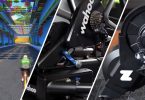

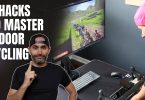


Thanks for the tips! I’ve only just started entering races on Zwift (and just got a mini keyboard for my handlebars so I can use power-ups) and I can certainly see there’s more tactics to these races than simply pedalling harder than the next guy!